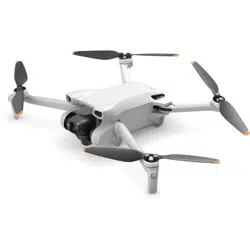Loading ...
Loading ...
Loading ...

DJI Mini 3
User Manual
29
©
2022 DJI All Rights Reserved.
Gimbal and Camera
Gimbal Profile
The DJI Mini 3 3-axis gimbal stabilizes the camera, allowing you to capture clear and steady
images and videos at high flight speed. The gimbal has a control tilt range of -90˚ to +60˚, and
two control roll angles of -90˚ (portrait) and 0˚ (landscape).
Use the gimbal dial on the remote controller to control the tilt of the camera. Alternatively, do
so through the camera view in DJI Fly. Press the screen until an adjustment bar appears and
drag up and down to control the camera’s tilt. Tap the Landscape/Portrait Mode Switch in DJI Fly
to switch between the two gimbal roll angles. The roll axis will rotate to -90° when Portrait Mode
is enabled, and back to 0° in Landscape Mode.
Gimbal Mode
Two gimbal operation modes are available. Switch between the different operation modes in DJI
Fly.
Follow Mode: The angle between the gimbal’s orientation and aircraft front remains constant at
all times. Users can adjust the gimbal tilt. This mode is suitable for shooting stills.
FPV Mode: When the aircraft is flying forward, the gimbal synchronizes with the movement of
the aircraft to provide a first-person flying experience.
•
Make sure there are no stickers or objects on the gimbal before taking off. When the
aircraft is powered on, DO NOT tap or knock the gimbal. Take off from open and flat
ground to protect the gimbal.
•
Precision elements in the gimbal may be damaged in a collision or impact, which may
cause the gimbal to function abnormally.
•
Avoid getting dust or sand on the gimbal, especially in the gimbal motors.
•
A gimbal motor may enter protection mode in the following situations: a. The aircraft
is on uneven ground and the gimbal is impacted. b. The gimbal experiences excessive
external force, such as during a collision.
•
DO NOT apply external force to the gimbal after the gimbal is powered on. DO
NOT add any extra payload to the gimbal as this may cause the gimbal to function
abnormally or even lead to permanent motor damage.
•
Make sure to remove the gimbal protector before powering on the aircraft. Make sure
to mount the gimbal protector when the aircraft is not in use.
•
Flying in heavy fog or clouds may make the gimbal wet, leading to temporary failure.
The gimbal will recover full functionality once it is dry.
-90°
0°
60°
Loading ...
Loading ...
Loading ...
